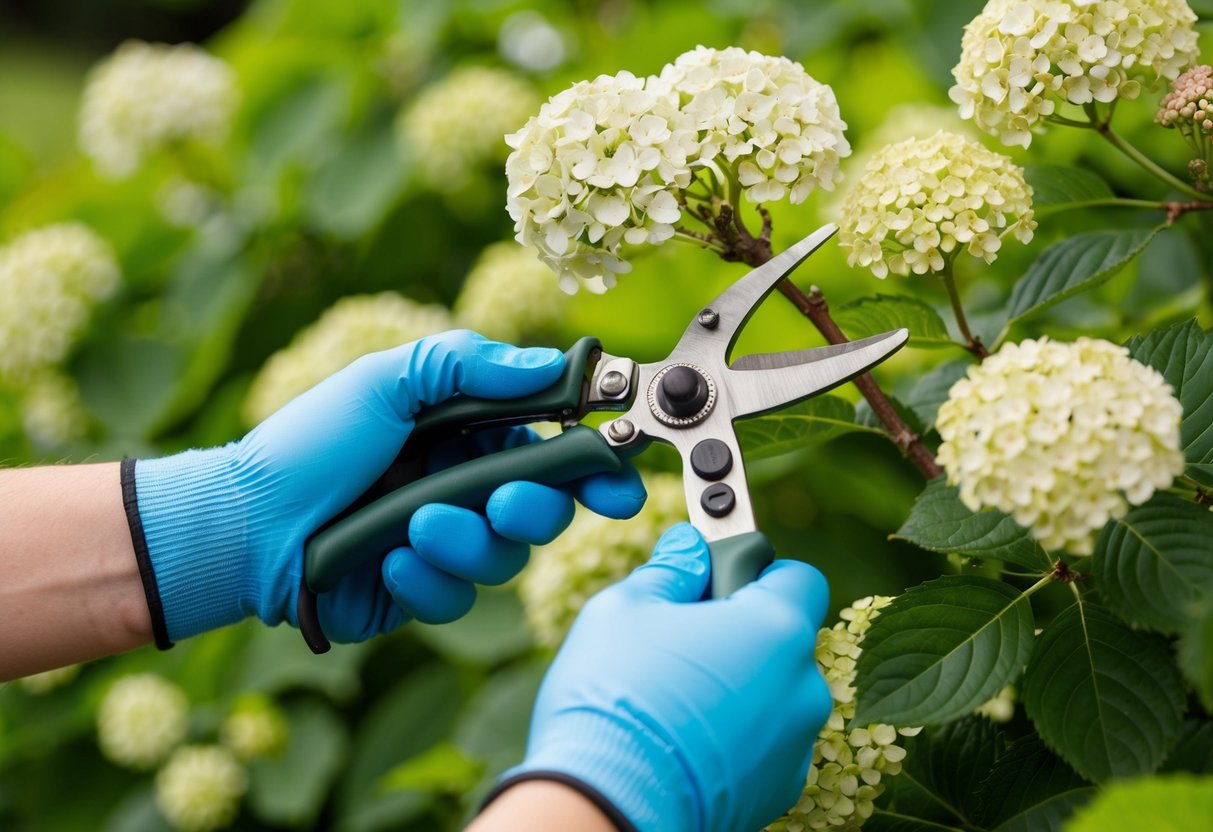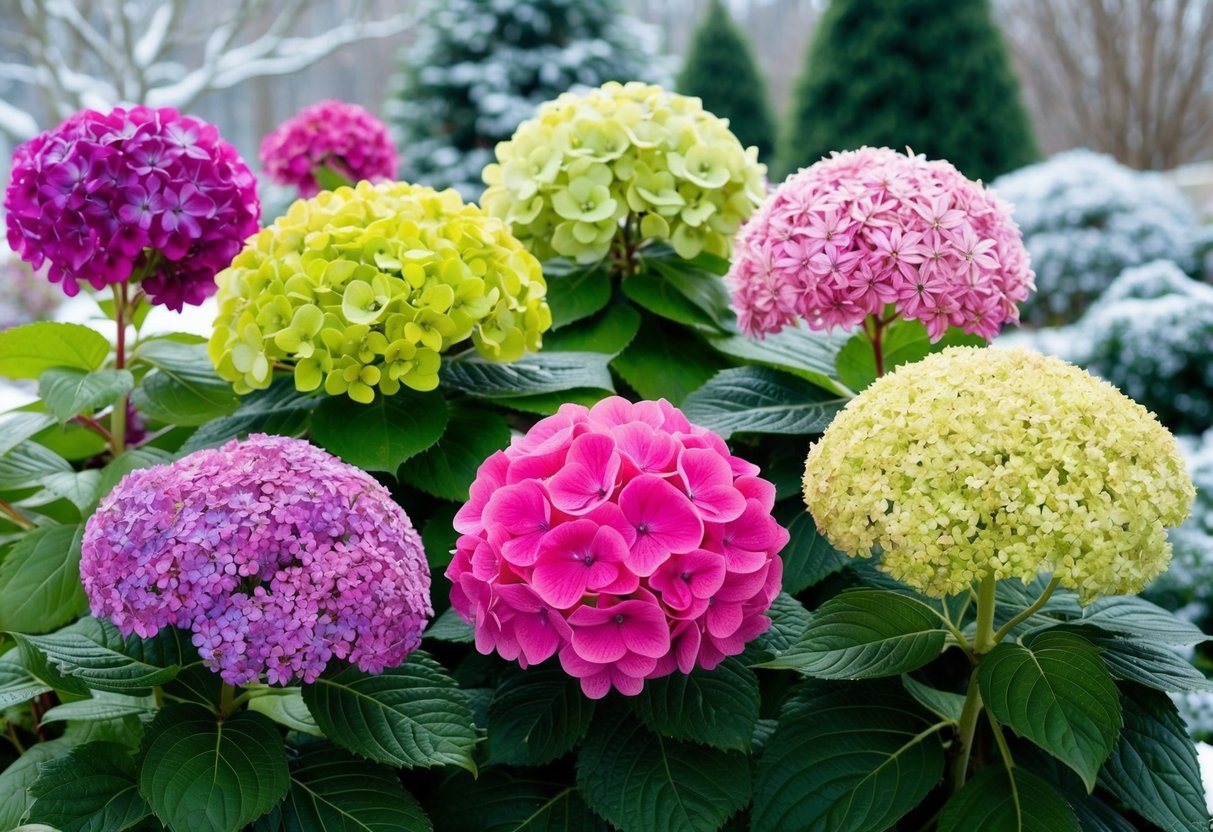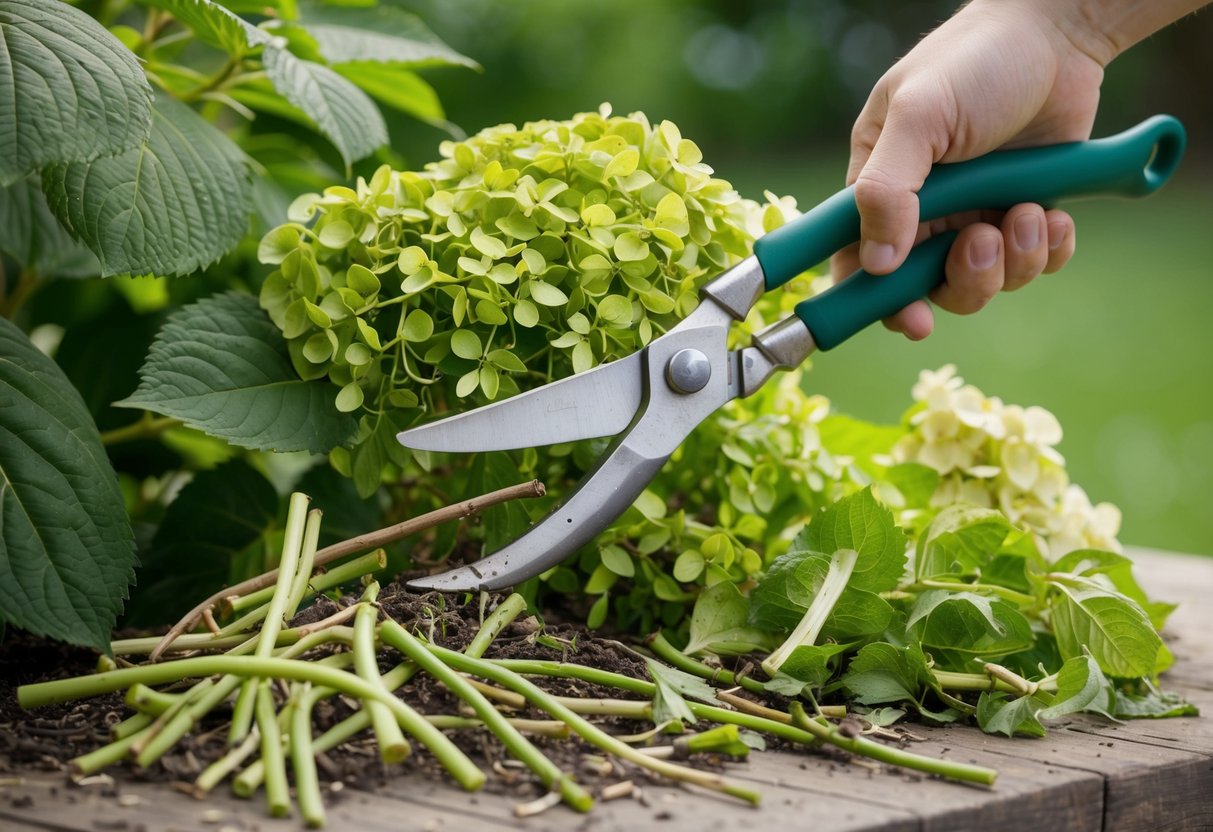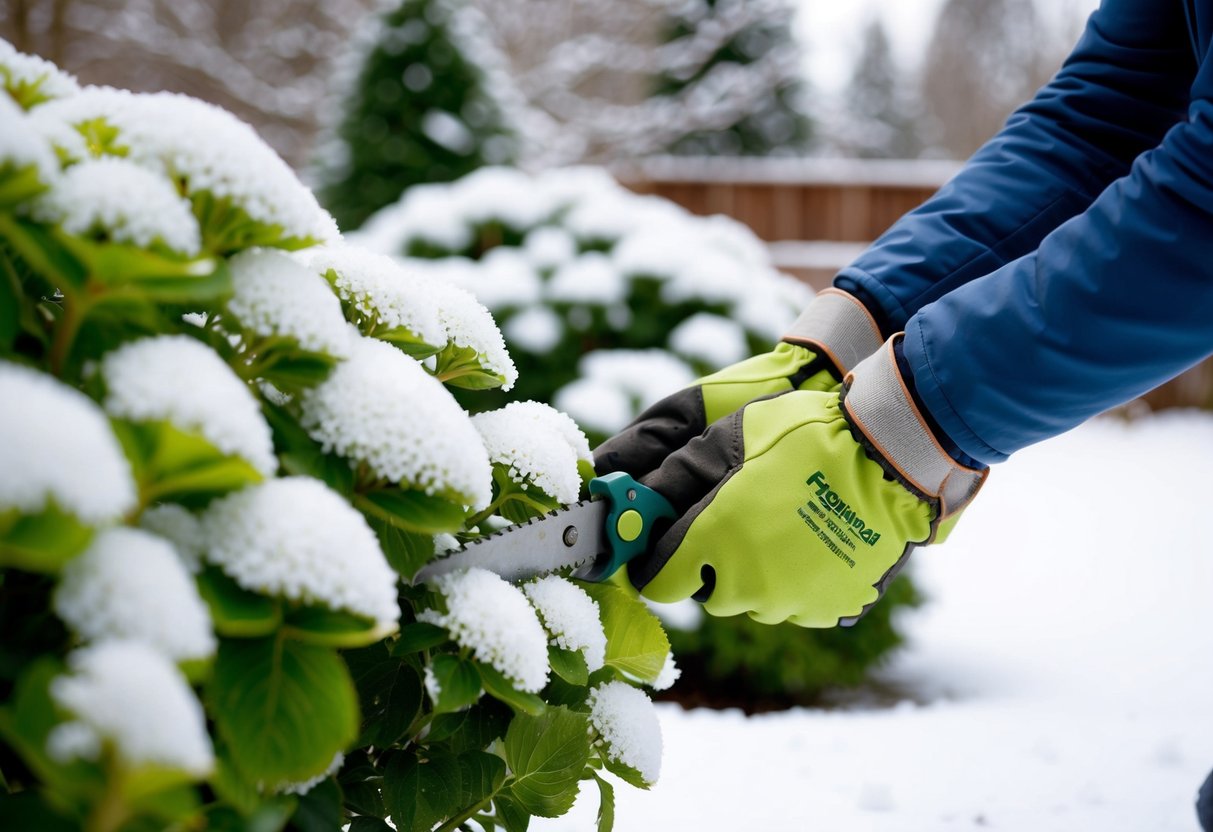Should Hydrangeas Be Cut Back for Winter? Expert Tips Inside
As the crisp air of winter approaches, you might be wondering about the best way to care for your hydrangeas. Should these beloved garden plants be cut back before the frost hits?
You should wait and prune your hydrangeas in the spring rather than in the fall or winter. This practice helps to protect your plants from harsh winter conditions, as any cuts made in the fall could leave them vulnerable to frost damage.

It’s important to understand the type of hydrangea you have. Some varieties form flower buds on new wood, while others form buds on old wood. Knowing this can guide you on how to handle pruning.
For instance, those that bloom on new wood can tolerate more aggressive pruning, whereas those that bloom on old wood may need a gentler approach to ensure you enjoy blooms the following season.
Taking these factors into account, your hydrangeas can thrive year after year. By timing your pruning right and understanding your plant’s needs, you’ll enjoy a beautiful display in your garden when spring arrives. Keep reading to learn more about the specifics of pruning and winter protection for your hydrangeas.
Understanding Hydrangea Varieties

Hydrangeas come in many varieties, each with unique characteristics. Knowing the type you have helps in understanding its maintenance needs, especially when deciding whether to cut it back for winter.
Bigleaf and Lacecap
Bigleaf hydrangeas (Hydrangea macrophylla) are popular for their vibrant blooms. They like moist but well-drained soil and often need some shade. These hydrangeas form buds on old wood, so pruning them in late summer is best.
Lacecap varieties are a type of bigleaf hydrangea. They have flat, delicate flowers surrounded by larger blooms. Similar to other bigleaf types, they flower on old wood. If you prune too much, you risk losing the next year’s flowers.
Panicle and Smooth
Panicle hydrangeas are known for their cone-shaped flower clusters. They are hardy and can tolerate colder climates. These hydrangeas bloom on new wood, so they can be pruned heavily in late winter or early spring without losing flowers.
Smooth hydrangeas are another type forming blooms on new wood. They flourish with regular pruning, and cutting them back to the ground in late winter or early spring can help encourage strong growth in the coming season. This makes them an easy choice for many gardeners.
Oakleaf and Climbing
Oakleaf hydrangeas have distinctively shaped leaves and can tolerate drier conditions. These hardy plants develop buds on old wood and shouldn’t be pruned too heavily if you want them to bloom well the next year.
Climbing hydrangeas are unique as they can grow up walls and fences. They’re more forgiving with pruning, but you should focus on trimming overgrown or dead branches. These plants prefer a bit of shade and can add a lot of charm to your garden.
The Importance of Pruning Hydrangeas

Pruning hydrangeas is key to maintaining their health and beauty. It encourages new growth and fuller blooms, ensuring your plants thrive and look vibrant.
Promoting Healthy Growth
When you prune hydrangeas, it helps remove dead or diseased wood. This gives the plant more energy to focus on new and healthy growth. Pruning hydrangeas also encourages the development of strong stems, which can support large and beautiful flowerheads.
Pruning time can vary depending on the type of hydrangea you have. Some types, like bigleaf or mophead, should be pruned just after their blooms fade. Others, such as panicle or smooth hydrangeas, respond well to more aggressive pruning in late winter or early spring, before the new buds form.
By removing old stems, you allow more light and air circulation. This helps prevent diseases and promotes overall plant health. With the right timing and technique, you can help your hydrangea produce a robust and vibrant display each year.
Encouraging Fuller Blooms
Pruning also plays a crucial role in encouraging fuller blooms. By cutting back old flowerheads, you stimulate the production of new ones. This can lead to a bushier plant with plenty of vibrant flowers.
When to prune hydrangeas can depend on the flower type and the climate. Some plants, especially those that bloom on new wood, may need aggressive pruning to promote fuller blooms. For those that bloom on old wood, a more gentle approach right after blooming works best.
Proper hydrangea pruning ensures your garden is filled with lush and colorful blooms. Following these tips can help your hydrangeas reach their full potential, giving you a beautiful garden to enjoy.
When to Prune Different Hydrangea Types

Pruning hydrangeas depends on whether they bloom on old or new wood. This timing ensures they develop strong, healthy blossoms. The type of hydrangea you have will guide you on when to trim.
Old Wood Hydrangeas
Hydrangea macrophylla fall into the category of old wood bloomers. They develop flower buds on last year’s growth. You should prune these right after they bloom in summer, before the buds for the next season start forming. Bigleaf hydrangeas like this need careful timing; cutting them in spring would risk losing blossoms.
Make clean cuts above a set of leaves. This pruning helps improve their structure and encourages new growth while reducing old, dead wood. Deadheading—removing spent flowers—should be done once the blooms fade, but actual structural pruning waits until summer.
New Wood Hydrangeas
New wood bloomers like the panicle hydrangea and Annabelle form buds on this year’s growth. These are best pruned in late winter or early spring, just before the new growth starts. By doing so, you allow them to grow vigorously in the spring, resulting in larger blossoms.
For instance, you can cut back Incrediball hydrangeas quite severely, even down to the ground. This ensures a neat form and energetic growth when the weather warms. Look out for stems that are floppy or overgrown, especially after rain. Trimming restores their shape.
Unique Pruning Times
Though most types are straightforward, some like Limelight can be pruned more flexibly. They usually require trimming in late winter or early spring, but some gardeners opt to prune them in the fall. Still, waiting until the cold weather passes reduces the risk of frost damage.
If your hydrangea seems too dense, removing some of the inner branches can improve air circulation and light. Always use sharp and clean tools to avoid any disease spread. For unique cases, focus on the health of the plant and its flowering behavior, adapting pruning times accordingly.
How to Prune Hydrangeas

Pruning hydrangeas correctly involves understanding which parts of the plant need trimming and how to use the right tools. You’ll also want to focus on removing old stems and deadheading spent blooms to ensure healthy growth.
Proper Pruning Techniques
To prune hydrangeas, identify the type you have, as different types require different pruning methods. For types like bigleaf and mountain hydrangeas, which form buds on old wood, avoid heavy pruning to protect next season’s flowers.
For others, like smooth or panicle hydrangeas, cutting back old stems to the ground encourages new growth. Always look for healthy buds and leaves to make your cuts just above them for the best results. Keeping this in mind helps maintain the plant’s health and encourages more blooms.
Tools for Pruning
Using the right garden tools makes a big difference in pruning hydrangeas. A pair of sharp pruning shears is essential for making clean cuts. This reduces damage to the plant and helps prevent diseases.
Long-handled loppers can reach higher branches and cut through thicker stems with ease. It’s also a good idea to have clean trimmers to avoid transferring pests or diseases between plants. Keeping your tools in good condition ensures effective and safe pruning throughout your garden.
Deadheading Spent Blooms
Deadheading, or removing spent blooms, is important for keeping your hydrangeas looking beautiful. This process involves cutting off old flowers that have faded or dried up.
Removing spent blooms redirects energy back into the plant, encouraging it to focus on growing and forming new flower buds. Make your cuts just above the first set of healthy leaves beneath each flower cluster. It’s a simple way to ensure your plant remains vibrant and blooms beautifully year after year.
Protecting Hydrangeas in Winter

To keep your hydrangeas safe and healthy, winter protection is key. Improving soil insulation, regulating water intake before freezing, and providing end-of-season care are essential steps. These actions ensure that your hydrangea flowers, like the mophead variety, are vibrant when they bloom again.
Mulching and Insulation
Mulching serves as a protective layer for hydrangeas, keeping the crown and roots safe from the cold. You can use straw or leaves for this purpose. Building a frame around your plants using stakes and chicken wire, then filling it with items like pine cones, offers extra insulation. This method prevents freeze damage and prepares your plants for dormancy, helping them thrive once warmer weather returns.
Watering Before Freeze
Watering your hydrangeas before the ground freezes is crucial. Hydrangeas need adequate moisture to remain healthy during their dormant period.
Simply ensure the soil is neither too dry nor waterlogged by reducing watering once the ground starts freezing. By doing so, you’ll protect the roots and help maintain blooms like those of the Endless Summer variety, which are known for their resilience.
End-of-Season Care
In late fall, take the time to tidy up your hydrangeas by trimming faded flower clusters. This not only enhances winter interest but also encourages robust growth in spring.
Depending on whether your soil is alkaline or acidic, you may need to adjust care practices to influence flower color. Being thoughtful in your care routines during this time ensures your hydrangeas are well-prepared for when they wake from dormancy.







